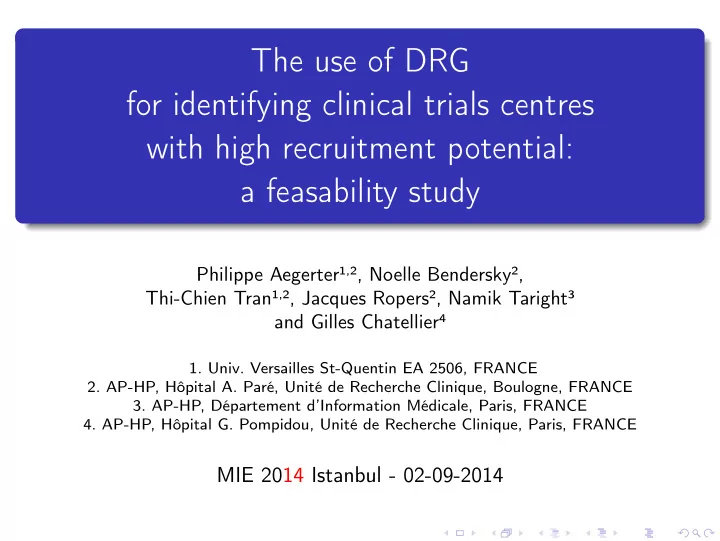

The use of DRG for identifying clinical trials centres with high recruitment potential: a feasability study Philippe Aegerter 1,2 , Noelle Bendersky 2 , Thi-Chien Tran 1,2 , Jacques Ropers 2 , Namik Taright 3 and Gilles Chatellier 4 1. Univ. Versailles St-Quentin EA 2506, FRANCE 2. AP-HP, Hôpital A. Paré, Unité de Recherche Clinique, Boulogne, FRANCE 3. AP-HP, Département d’Information Médicale, Paris, FRANCE 4. AP-HP, Hôpital G. Pompidou, Unité de Recherche Clinique, Paris, FRANCE MIE 2014 Istanbul - 02-09-2014
Rational Objectives Material and methods Results Discussion Clinical Trials The mean for assessing (internal validity) and enhancing standards of care (recommandations) But external validity requires large sample of heterogeneous patients numerous and different centres Reality is cruel one half of trials achieved original recruitment target [Sully 2013] one third to one half of centres did not recruit (or so few) Having a good estimate of the sample size and of recruitment has important consequences ethics validity cost, notably opening centres MIE 2014 philippe.aegerter@apr.aphp.fr Pred-Inclus 02-09-2014 2 / 15
Rational Objectives Material and methods Results Discussion Clinical Trials Recruitment Support System Why ? correlation between number of treated patients with the real inclusion capacity [London 2013] centres with pre-trial recruitmennt assessment more often reach the target How ? cohort identification using electronic medical records hot topic : 28 systems in a 2011 review [Cuggia] , 78 in 2014 [Köpke] , EHR4CR initiative But very few CTRSS were assessed against a large number of trials most of them relied on proprietary HIS MIE 2014 philippe.aegerter@apr.aphp.fr Pred-Inclus 02-09-2014 3 / 15
Rational Objectives Material and methods Results Discussion Aim Developpement of a pre-recruiment system for estimation of the set of eligible patients (not a real-time inclusion alert) using commonly available data Feasability study involving a large number of trials Evaluation criteria content coverage precision influence of trial characteristics MIE 2014 philippe.aegerter@apr.aphp.fr Pred-Inclus 02-09-2014 4 / 15
Rational Objectives Material and methods Results Discussion Material : EHR French national DRG database (PMSI) each stay in each acute hospital standardised case record compiled at discharge extensive quality checks Contains demographics : gender, age, dates of stays, hospital id diagnoses : coded with ICD-10 procedures : CCAM, multiaxial classification treatments : some, if expensive no free-text privacy : stays of one patient are linked but anonymous at the national level the playground : AP-HP Paris university care institution = 25 acute care hospitals around 1.2 million discharge records a year MIE 2014 philippe.aegerter@apr.aphp.fr Pred-Inclus 02-09-2014 5 / 15
Rational Objectives Material and methods Results Discussion Material : CR Protocols eligibility criteria inclusion : all are mandatory • demographics, nosology (diagnosis, findings, scores), consent non inclusion : one is enough • demographics, organ failures, drugs contra-indications Protocols under evaluation multicentre (within AP-HP) various clinical areas : oncology, cardio-vascular, neurology, rheumatology, ... closed in 2010-2011, in order to compare estimated and observed recruitment MIE 2014 philippe.aegerter@apr.aphp.fr Pred-Inclus 02-09-2014 6 / 15
Rational Objectives Material and methods Results Discussion Material : Protocols eligibility criteria MIE 2014 philippe.aegerter@apr.aphp.fr Pred-Inclus 02-09-2014 7 / 15
Rational Objectives Material and methods Results Discussion Methods : the go-between Formal representation of eligibility criteria 9 categories : demographic, medical history, clinical scores and symptoms, diagnoses, laboratory tests, procedures, treatments, adverse events and others corresponding sources and items in the database operators : boolean and choronological (delays) Transcoding performed by 2 professionals on a criteria standardised form independance between data and program Executable SQL queries automaticaly generated from criteria form MIE 2014 philippe.aegerter@apr.aphp.fr Pred-Inclus 02-09-2014 8 / 15
Rational Objectives Material and methods Results Discussion Methods : criteria standardised form MIE 2014 philippe.aegerter@apr.aphp.fr Pred-Inclus 02-09-2014 9 / 15
Rational Objectives Material and methods Results Discussion Results : ressources 85 protocols library of precoded common situations time needed for transcoding 1 protocol : 1-2 days time needed for query on AP-HP DRG database : 1-2 hours numbers are medians MIE 2014 philippe.aegerter@apr.aphp.fr Pred-Inclus 02-09-2014 10 / 15
Rational Objectives Material and methods Results Discussion Results : content coverage inclusion / non inclusion criteria : 60 % / 80 % translated most criteria were diagnostic criteria, 94 % translated MIE 2014 philippe.aegerter@apr.aphp.fr Pred-Inclus 02-09-2014 11 / 15
Rational Objectives Material and methods Results Discussion Results : precision strong reduction of eligible patients (mostly after 5-6 criteria) final number of records would allow manual verification but depending on clinical areas MIE 2014 philippe.aegerter@apr.aphp.fr Pred-Inclus 02-09-2014 12 / 15
Rational Objectives Material and methods Results Discussion Discussion What has been achieved large feasability study good content coverage What is still to be done comparison with whole patient record → precision, sensitivity at the patient level Limits ”low tech", rely on coder ability poor performance when scores or lab tests rely on structured data MIE 2014 philippe.aegerter@apr.aphp.fr Pred-Inclus 02-09-2014 13 / 15
Rational Objectives Material and methods Results Discussion References Cuggia M, Besana P, Glasspool D. Comparing semi-automatic systems for recruitment of patients to clinical trials. Int J Med Inform. juin 2011 ;80(6) :371388. Köpcke F, Prokosch HU. Employing computers for the recruitment into clinical trials : a comprehensive systematic review. J Med Internet Res. 2014 Jul 1 ;16(7) :e161. doi : 10.2196/jmir.3446. London JW1, Balestrucci L, Chatterjee D, Zhan T. Design-phase prediction of potential cancer clinical trial accrual success using a research data mart. J Am Med Inform Assoc. 2013 Dec ;20(e2) :e260-6. doi : 10.1136/amiajnl-201 Sully BG, Julious SA, Nicholl J. A reinvestigation of recruitment to randomised, controlled, multicenter trials : a review of trials funded by two UK funding agencies. Trials. 2013 Jun 9 ;14 :166. doi : 10.1186/1745-6215-14-166. MIE 2014 philippe.aegerter@apr.aphp.fr Pred-Inclus 02-09-2014 14 / 15
Rational Objectives Material and methods Results Discussion Aknowledgements Thank you for your attention CeNGEPS for funding F Willig, Clinical Research Dpt (DRCD) AP-HP, for help MIE 2014 philippe.aegerter@apr.aphp.fr Pred-Inclus 02-09-2014 15 / 15
Recommend
More recommend